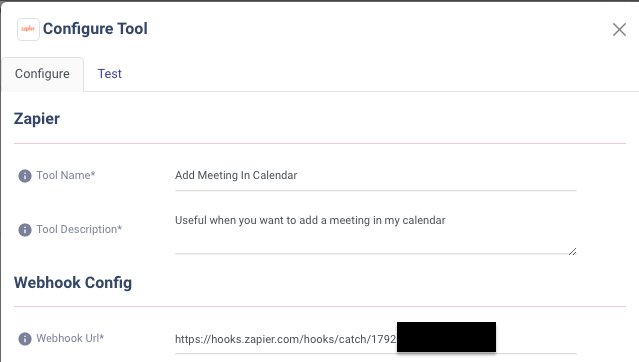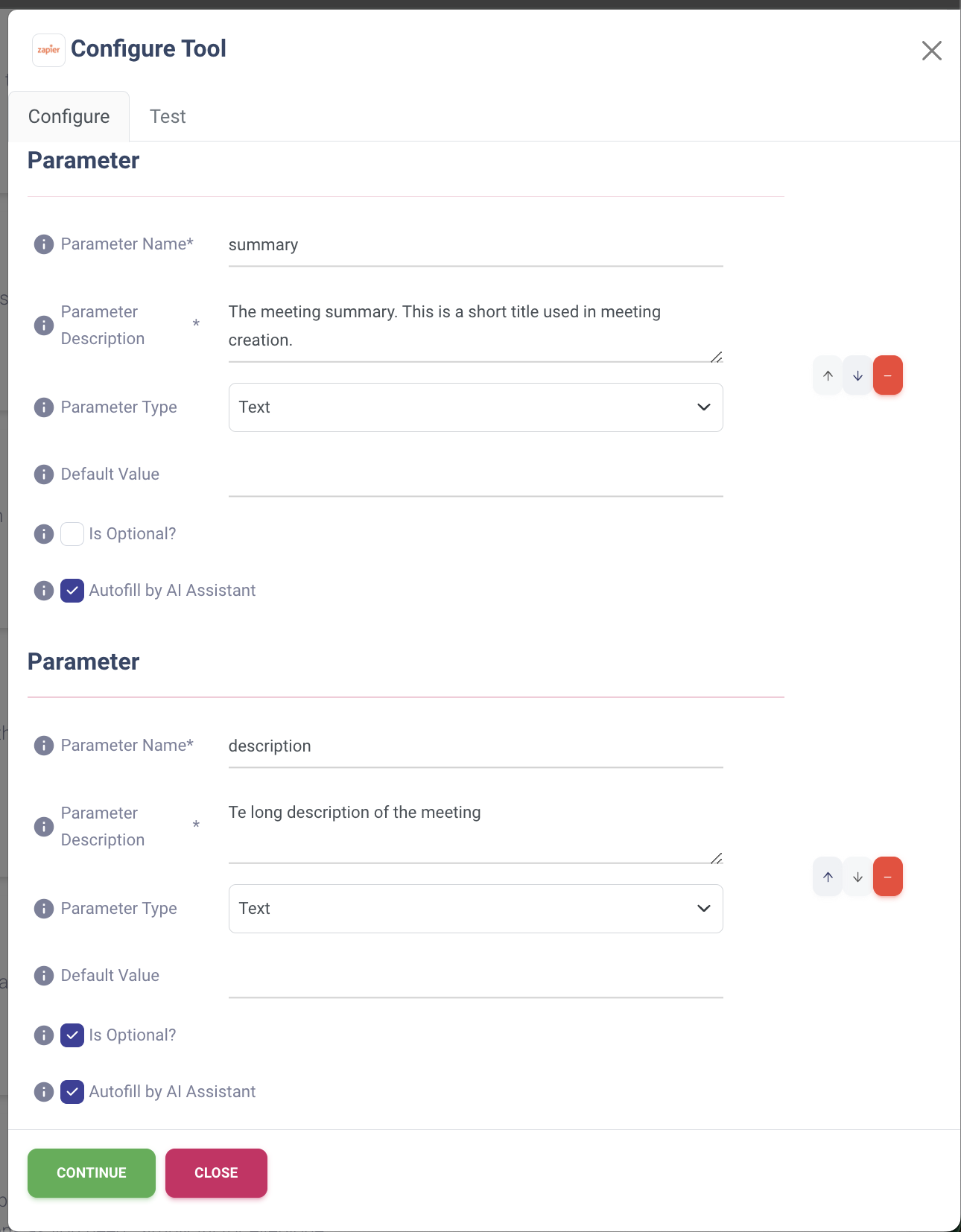Zapier Webhook
Integrating Zapier with your AI Assistant can significantly automate your workflow, connecting your AI Assistant with over 6,000 apps. This guide is designed to help non-technical users set up a Zapier webhook quickly and easily, enabling your AI Assistant to add data to other systems, trigger workflows, or even update databases without writing a single line of code.
What You’ll Need
- A Zapier account.
- Access to your AI Assistant’s dashboard.
Setting Up Zapier Step By Step
Before configuring the tool in our app, you need to create a "Zap" (an automated workflow) in Zapier. After setting up your Zap in Zapier, you'll need to configure the corresponding tool in your AI Assistant's dashboard.
- Log into Zapier and click the Create Zap button.

- Choose a Trigger App: This is an event in an app that starts your workflow. For your AI Assistant, select the app you want to integrate with (e.g., Gmail for sending emails).

- Select Webhooks by Zapier: This is the trigger that will start your workflow.

- Select the Catch Hook Event

- Copy the Webhook URL: This is the url that should be configured in Cubeo AI app.

- Configure the Zapier tool for your AI Assistant: Go to Cubeo AI app in the AI Assistant
Toolstab and selectZapiertool, then click configure.

- Add a name, a description and the Webhook URL: Give it a name, a description where you instruct the assistant how to use this tool and paste the Webhook URL copied at step 5.

- Configure Parameters: Configure what data do you need to send to zapier. These are the parameters the AI Assistant will collect from users and send to Zapier.

- Test Your Tool: Once you have configured the data to be collected, you are able to test your webhook. Configure the test parameters and test your tool. You'll see the raw response from Zapier and can see if it was successfully or not.

- Check the Test in Zapier: If the test is successfully, you can check the test data configured at the previous step in Zapier.

- Start Building Your Workflow: Once you have tested your webhook, you are able to add new steps to your zap. The sky is the limit!

Configuration Fields Explained
- Name: This is how you'll identify the tool within your AI Assistant (e.g., "Add Meeting In Calendar"). Stick to alphanumeric characters, underscores, spaces, and dashes.
- Description: Describe what the tool does (e.g., "Useful when you want to add a meeting in my calendar"). This helps in identifying the tool's purpose and helps AI Assistant to decide when the tool should be used.
- URL: The webhook URL provided by Zapier when setting up the "Webhooks by Zapier" action.
- Parameters: The data your AI Assistant will send to Zapier. For instance, if your Zap adds an event in calendar, you might need parameters like "attendees" and "summary" (or meeting title).
Example Use Case
Let’s say you are a sales man that wants to build an AI Assistant for personal use. A repetitive task a sales man does is to book meetings with their clients. For this you want a quicker solution for add you automatically a meeting in your calendar:
- Configure an AI Assistant of type
Custom Agentin Cubeo AI -- You firstly need to create a new AI Assistant in Cubeo AI app of typeCustom Agent. This type allows you to interact with tools. - Configure a Zapier tool -- You need to configure a Zapier tool that adds a meeting in your calendar:
- Tool Name:
Add Meeting In Calendar - Tool Description:
Useful when you want to add a meeting in my calendar - Webhook Url:
<the webhook url provided by Zapier at step 5 above> - Request Parameters:
- summary:
- Parameter Name:
summary - Parameter Description:
The meeting summary. This is a short title used in meeting creation. - Parameter Type:
Text - Is optional?:
Unchecked-- this tells the AI Assistant that it should always provide a short summary of the meeting - Autofill by AI Assistant:
Checked-- this option exposes the parameter to AI Assistant so it can provide a summary by itself
- Parameter Name:
- description:
- Parameter Name:
description - Parameter Description:
Te long description of the meeting - Parameter Type:
Text - Is optional?:
Checked-- this tells the AI Assistant that this parameter is not required so it can skip providing it - Autofill by AI Assistant:
Checked-- this option exposes the parameter to AI Assistant so it can provide a description by itself
- Parameter Name:
- start_date_time:
- Parameter Name:
start_date_time - Parameter Description:
The start date and time of the meeting. Should be in format Y-m-d H:i:s in Pacific Timezone - Parameter Type:
Text - Is optional?:
Unchecked-- this tells the AI Assistant that this parameter is required and it should always provide a start date to add a meeting - Autofill by AI Assistant:
Checked-- this option exposes the parameter to AI Assistant so it can provide a start date and time from user message by itself
- Parameter Name:
- end_date_time:
- Parameter Name:
end_date_time - Parameter Description:
The end date and time of the meeting. Should be in format Y-m-d H:i:s in Pacific Timezone - Parameter Type:
Text - Is optional?:
Unchecked-- this tells the AI Assistant that this parameter is required and it should always provide an end date to add a meeting - Autofill by AI Assistant:
Checked-- this option exposes the parameter to AI Assistant so it can provide an end date and time from user message by itself
- Parameter Name:
- attendees:
- Parameter Name:
attendees - Parameter Description:
The emails of the participants in the meeting - Parameter Type:
List Of Text-- because a meeting could have many participants, we tell the AI Assistant that it is a list of emails. - Is optional?:
Checked-- because you can use the tool to simply add a reminder in your calendar for yourself - Autofill by AI Assistant:
Checked-- this option exposes the parameter to AI Assistant so it can provide a list of attendees
- Parameter Name:
- summary:
- Tool Name:
- Test Your Tool: Once you defined all parameters for your request, you have to test it to be sure everything works as expected.
- Check The Test in Zapier: You have to check the test in Zapier and connect your Google Calendar to register your meeting.
- Test Your AI Assistant: Now when everything is set up, you can ask your assistant:
Add me a meeting for tomorrow at 14:00 for 30 min with member1@cubeo.aiand you will see your meeting added in your calendar 📅 🥳
As simple as saying Cubeo AI, you'll have your personal assistant in 5 min 😎
Best Practices
- Test Your Zapier Connection: Always test the connection between your AI Assistant and Zapier to ensure smooth operation.
- Keep Parameters Relevant: Only include necessary parameters to avoid overloading your request with unnecessary data.
- Secure Your Webhook: Ensure your webhook URL is kept confidential to prevent unauthorized access.
By following these steps, you can seamlessly integrate Zapier with your AI Assistant, automating your workflows and enhancing your productivity without needing to delve into technicalities. This powerful integration opens up endless possibilities for automating tasks, allowing you to focus more on what truly matters for your business.